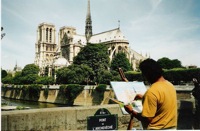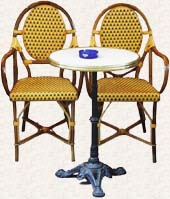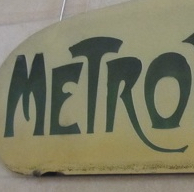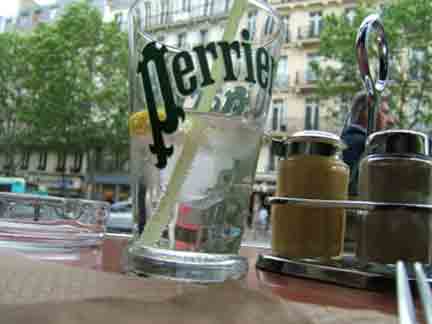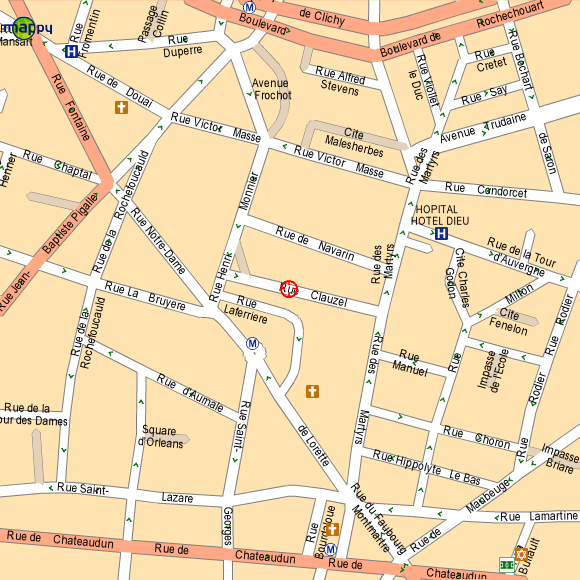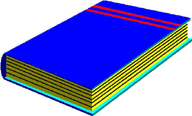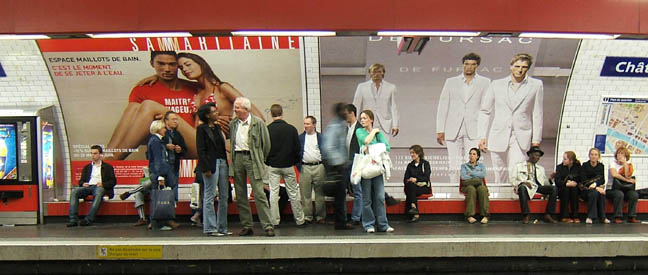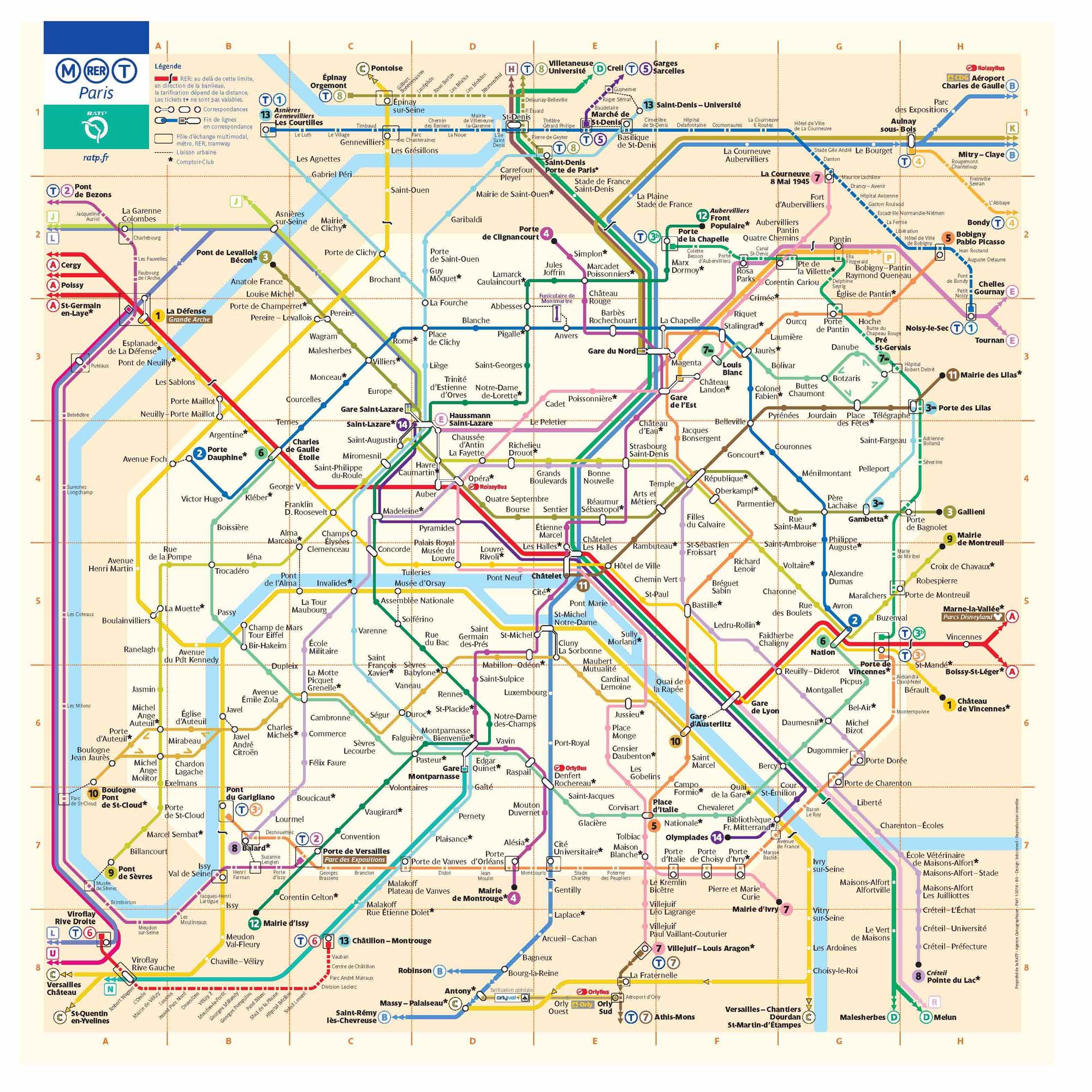Transportation within Paris
The metro, of course. Easy to use and it'll get you anywhere. A written description of how to use the metro would appear mystifying and obtuse; once you take the thing two or three times it will be so obvious how it works that you'll just laugh at how stupid you were the first time you did it. I know: how are you going to 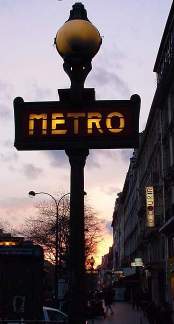 get someplace the first time? Beats me. Try your luck. Just keep in mind that you always need to know the name of the direction you're going, not the line number alone. The name of the direction is simply the name of the last stop on the line; look at the map and follow the line to the end: there's your name. Each line thus has two names, depending on whether you're going or coming.
get someplace the first time? Beats me. Try your luck. Just keep in mind that you always need to know the name of the direction you're going, not the line number alone. The name of the direction is simply the name of the last stop on the line; look at the map and follow the line to the end: there's your name. Each line thus has two names, depending on whether you're going or coming.
The metro, of course. Easy to use and it'll get you anywhere
Check out the map at the bottom of this page. Line 4 (sort of maroon, in the north central part of the city) is called Porte de Clignancourt if you're traveling north, and Montrouge (Mairie de Montrouge) if you're traveling south (follow it to the end).
You can transfer between lines at stops that are marked with an open circle, called a correspondance, and in the stations those are always marked with an orange banner. Look for the name of the direction (last stop) on the line you're transferring to, and get on that line.
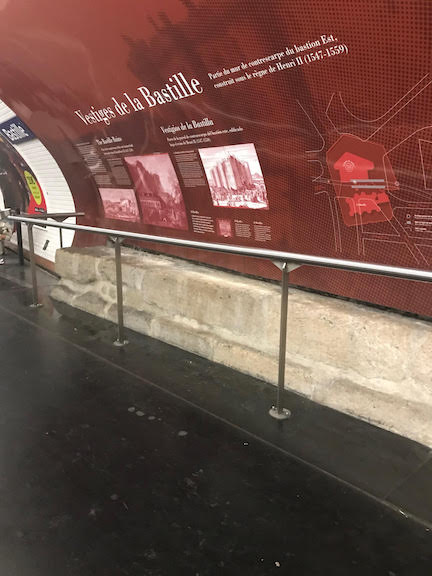 Some of the stations, especially those in historical areas or those that service major monuments and such, have little mini-exhibits on the platforms. Others, especially at older sites, have archeological digs and you get to see some remnants of former structures or other such things. Here you see the remainder of part of the original foundation of the Bastille (cool, huh?).
Some of the stations, especially those in historical areas or those that service major monuments and such, have little mini-exhibits on the platforms. Others, especially at older sites, have archeological digs and you get to see some remnants of former structures or other such things. Here you see the remainder of part of the original foundation of the Bastille (cool, huh?).
| OK, because people have been asking and because you can't seem to take any initiative, here's a brief lesson on how to take the metro. |
The newer lines, and those that have been renovated, are nearly completely automated, some without drivers. They have these transparent walls on the platforms to keep you from hurtling yourself onto the tracks, and when the trains come the doors open automatically. In some of the trains you can stand at the very head of the train, where the drivers are in the manually operated trains, and watch as the train flies forward. Sometimes you have to push little kids out of the way to do this, but it’s really fun.
If you’re feeling brave and adventurous, try to figure out the bus system; you can see things and get a better sense of where you are. It’s not that hard to figure out, but sometimes you go places you hadn’t planned on going, which, I guess, isn’t so bad. Metro tickets work on the busses as well—you can ride pretty much as far as you want—within the city of Paris—on just one ticket. They used to have this really baroque zone system requiring different numbers of tickets, but that’s gone by the wayside, unless you want to take the bus to the suburbs, which you won’t.
There are plenty of electronic metro and bus maps to be had, with some of the most comprehensive to be found at the Transilien site and the RATP site (with the latter easier to use in Tom's opinion).
If you arrive on a Sunday or Monday—and especially if you arrive on or about the first of the month and you'll be staying for a while—it’ll be cheaper (and cooler) for you to buy a weekly or monthly pass, good for unlimited metro and bus travel. Getting one of these passes is dramatically easier than it used to be, and it's very high tech and very fun. The Passe Navigo (Découverte) looks like a thick credit card, it has your picture and your name on it, and it's somehow mysteriously encoded so all you have to do is wave it at the turnstiles and zip! you're in (I put the word "Découverte" in parentheses because unless you're a resident of the Paris region, you can't get a full-blown Passe Navigo, which is pretty much the same thing anyway; no one calls it "Découverte," though). The first thing to do is to find a machine that takes pictures, like the ones they have in K-mart or in amusement parks (they’re all over the place in Paris because you need an ID card with a picture on it to do just about anything, and if you have to ask for one they’re called "photomatons"), and get a picture of your head. Then,take it to the ticket counter in the metro and tell the person you want a "passe navigo," and he or she will cut up your picture so it fits on the card and seal the thing up so it looks like it might contain some precious document and you're on your way. It takes minutes. However, I’d do this at a metro station that isn’t busy—and for God’s sake 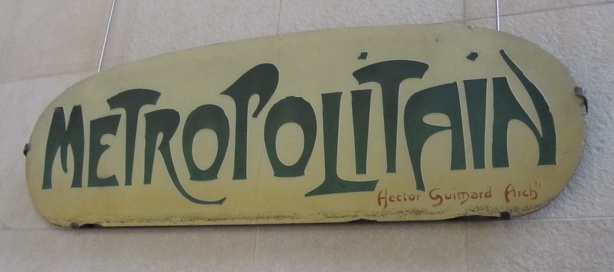 don’t do it at rush hour or you might be killed—because if you get a frazzled or impatient ticket seller, or if the line is long, this could turn out to be a difficult and harrowing nightmare. By the way, when they ask for your "nom et prénom" (family and first names) you can be cool and write it like this: FAMILY, First (i.e., family name in all caps, and then first name—and family name always comes first). The weekly pass is good from Monday morning through Sunday night and is about 22 euros; the monthly pass runs from the first of the month through the very end and is about 75. After you get your first pass, you can renew them automatically in these cool vending machines. You insert your pass, insert your money, and the machine somehow magically recharges your card. One thing that won't be obvious when you re-load your card is that you have to select 5 zones—you'll see what I mean—when that option comes up, because the Navigo card is good for all zones. If you try to select fewer it won't let you, and the price is the same for 5 zones or for 1 (which you can't select anyway.) Oh, and by the way: the "Métropolitain" design you see here—and which you'll still see around town in some places—was originally created by Hector Guimard in 1900. The model you see here is hanging in the Musée d'Orsay.
don’t do it at rush hour or you might be killed—because if you get a frazzled or impatient ticket seller, or if the line is long, this could turn out to be a difficult and harrowing nightmare. By the way, when they ask for your "nom et prénom" (family and first names) you can be cool and write it like this: FAMILY, First (i.e., family name in all caps, and then first name—and family name always comes first). The weekly pass is good from Monday morning through Sunday night and is about 22 euros; the monthly pass runs from the first of the month through the very end and is about 75. After you get your first pass, you can renew them automatically in these cool vending machines. You insert your pass, insert your money, and the machine somehow magically recharges your card. One thing that won't be obvious when you re-load your card is that you have to select 5 zones—you'll see what I mean—when that option comes up, because the Navigo card is good for all zones. If you try to select fewer it won't let you, and the price is the same for 5 zones or for 1 (which you can't select anyway.) Oh, and by the way: the "Métropolitain" design you see here—and which you'll still see around town in some places—was originally created by Hector Guimard in 1900. The model you see here is hanging in the Musée d'Orsay.
Metros and busses are patrolled by people in smart blue uniforms called controleurs (control freaks?), and they can fine you and humiliate you and just make things in general unpleasant for you if you don't have the proper credentials. If you don't, you're in what's called a SITUATION IRREGULIERE, and many people who have been in this situation were never heard from again.
If you arrive at an inappropriate time to take advantage of this, or if you are too chicken to try, then buy your tickets (which are good for the metro and the bus) in books of ten called "carnets." Ask the ticket seller for "unh karnay" and it will cost about 12 €. Buying single tickets is expensive and time consuming, so don’t be stupid and do that. If you do end up buying tickets, in whatever fashion, put one through the turnstile and then keep it with you until you exit the system. There are those damned metro police throughout the system, (whom you are not likely to see, but still...) and they can ask to see your ticket at any time, in the station or on the trains, and they can tell, somehow, if you have a valid ticket). On the bus, stick the ticket in the little machine by the driver or wave your passe navigo at the device.
You'll find absolutely everything there is to know about the metro and any other sort of transportation in and around Paris on the transilien site (and there's a link there for getting info in English). If you're worried about strikes or work being done on the métro or the RER (say you're planning on getting to or from the airport), click on the link for "perturbations." They have a tremendously cool interactive metro map on this site, and you click on your departing and 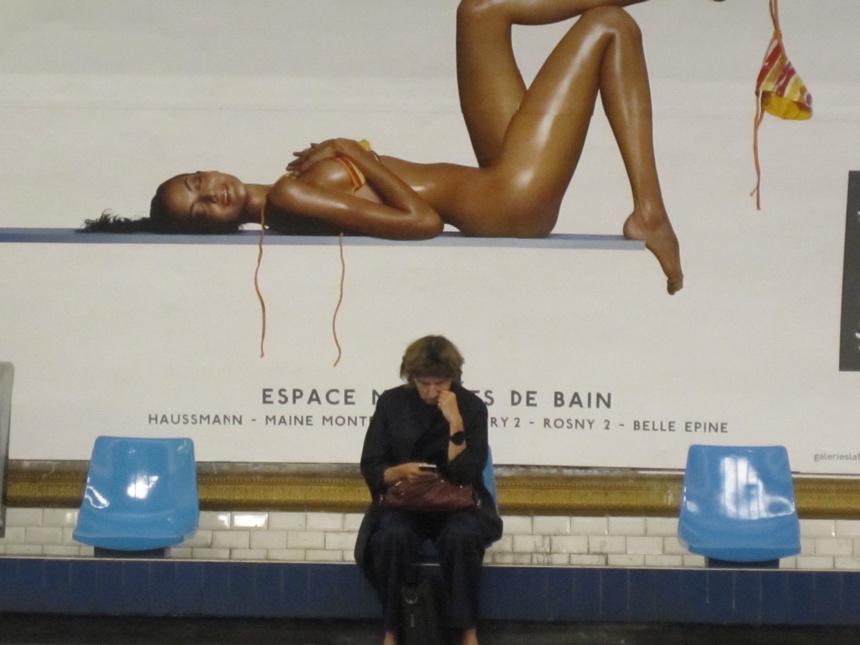 arriving stations and it gives you all sorts of possibilities—metro, RER, bus, walking—for making the trajectory, with its own, sometimes surprising, recommendations.
arriving stations and it gives you all sorts of possibilities—metro, RER, bus, walking—for making the trajectory, with its own, sometimes surprising, recommendations.
Sandy highly recommends the Batobus, a boat (bateau, pronounced "bato" + bus—get it?) that takes you up and down the Seine, stopping at select locations. You can buy a pass good for 1, 2, or 5 days (11, 13, 16 euros, respectively) or good for a whole year for 50 euros. Check them out at batobus.com (and they have some nice photos of their boats, their stops, and the neighborhoods where they dock).
The bus system isn't that hard to figure out, but sometimes you go places you hadn’t planned on going.
Getting around at night. The metro closes at about 1:15 am (or 2:15 on weekends and before holidays)—and this varies, so don't push your luck—and doesn't open again until about 5:00 am. (And here's a cool
thing: you'll know if you made the last metro if you note as the train pulls into the station that the two lights placed above the windshield on the front of the train are flashing slowly [as opposed to being just on]. Cool, huh? Almost no one knows this. I’m not sure the value of this, except you can feel all, “whew! we just made it!” when you do.) If you're going to be out after this (and you will be) then you must do one of several things: stay in your neighborhood, walk, take a cab or an Uber (which works very well here), or venture into the exciting world of the night buses. I, of course, am all for the exciting world of the night buses—Noctilien. The night busses travel a different schedule from the day busses; they come slightly less frequently (although on weekends it's something like every ten minutes), and they cover slightly less ground, so unless you happen to be staying right on the night bus's route, you'll probably have to walk a bit when you get off, but so what? Here's a lot of official information in English on the Noctilien. You can recognize where the night buses stop by this helpful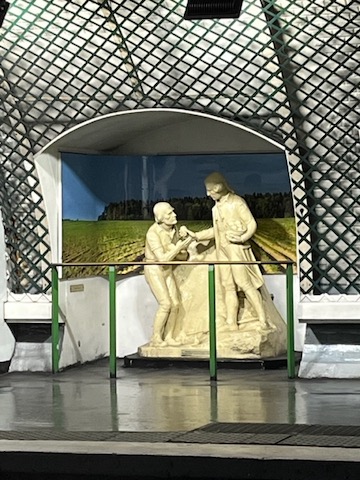 little "N" and by the lovely dark blue color scheme. If you have a passe navigo (monthly or weekly) this is all you need. If you're using single tickets the night bus costs more, but no one knows how much, and the bus driver won't tell you.There's something about t+ tickets, and Tom has no idea what these are or how or why you'd get them. The people on the night bus all look angry and mean, and some of them are. Do not get into a conversation with any of them, especially if you are by yourself. Most of them will be drunk. If you just mind your own business, however, you'll really be fine—people have other things on their mind than worrying about your cheap self.
little "N" and by the lovely dark blue color scheme. If you have a passe navigo (monthly or weekly) this is all you need. If you're using single tickets the night bus costs more, but no one knows how much, and the bus driver won't tell you.There's something about t+ tickets, and Tom has no idea what these are or how or why you'd get them. The people on the night bus all look angry and mean, and some of them are. Do not get into a conversation with any of them, especially if you are by yourself. Most of them will be drunk. If you just mind your own business, however, you'll really be fine—people have other things on their mind than worrying about your cheap self.
Taxis, it must be said, are not terribly expensive, and might be your best alternative if you're not feeling terribly adventurous of if you don't know your way around the city very well yet. Despite the horror stories about Parisian cab drivers, I've never really met a hideously dishonest one.
Finally, you need to know that Uber functions fully well in Paris. If you have the app on your phone, you can use it just like you would if you were in the US. As of this writing, Lyft is not in Paris.
Get all the information you can stand on the metro, in English, at http://www.ratp.fr
Check out Bob Reynolds' amazing Subway Page for insanely interesting info on public transportation the world round.
